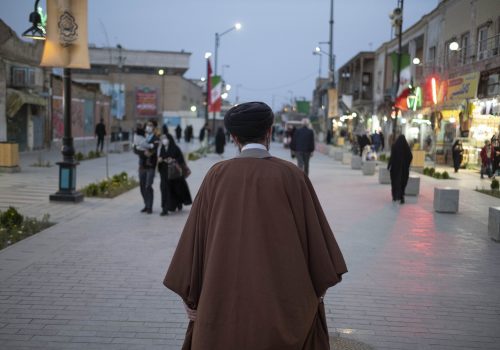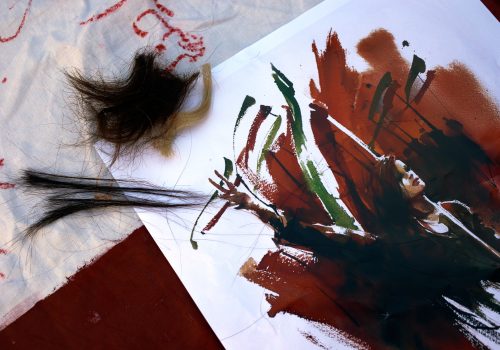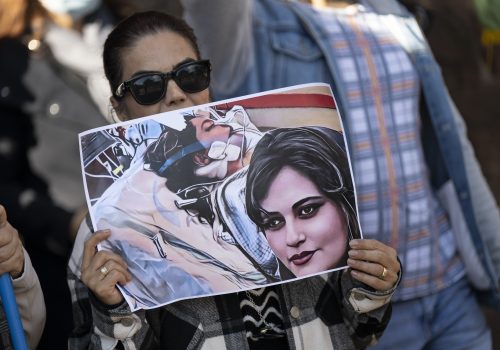UNICEF isn’t doing enough to protect Iranian children during protests. It’s time they step up.
The sweeping nationwide protests that followed the death of Mahsa Jina Amini in police custody on September 16, 2022 have been distinct from previous rounds of uprisings in Iran. Aside from the inclusive nature of the movement, which has straddled social boundaries and unified people of all stripes, the government crackdown has also been unprecedented.
To quell what appeared to be a thundering revolutionary wave, the Islamic Republic unleashed violence, killing at least 524 people, making over nineteen thousand arrests, and, for the first time in years, engaging in a head-on confrontation with the nation’s most prominent artists, athletes, and celebrities who sympathized with the protesters.
However, what was most striking was the government’s targeting of children under the age of eighteen, which generated widespread fury and drew international condemnation. The deaths, which, in some instances, have resulted in cover-ups and the disappearing of bodies, unmasked the lengths to which authorities were prepared to go to stem the upheaval and persuade protesters to go back home.
In December 2022, Amnesty International documented the details of at least forty-four children killed during the protests, reporting that people under eighteen represented 14 percent of the overall deaths of protesters and bystanders. This is while the Human Rights Activists News Agency chronicled a total of seventy-one children killed as of January 17.
The toll from the protests on Iranian children has been massive. They have been exposed to scenes on the streets that have been shocking at best and will evolve into long-term traumas. The security apparatus has used school premises for maintaining anti-riot equipment and vehicles, which is not only an infringement of the sanctity of the educational space, but will impinge on the relationship between children and the learning venues they cherish as their second homes.
There have also been numerous accounts of security forces making incursions into school compounds to arrest high school students who pro-government school principals revealed to be engaged in simple acts of protest or removing of their headscarves. This represents a betrayal of the principles on which schools are founded, but also takes repression to a new level, signaling that, to stifle dissent, the government is ready to assail places as harmless as schools and persecute adolescents.
In the province of Ardabil, where several incidents of raids on schools have been reported, the death of Asra Panahi, a fifteen-year-old high school student who was beaten by guards, touched many nerves and made the headlines. She was one of several students of the Shahed Girls High School who refused to perform a government-sponsored revolutionary song and faced backlash from school officials. Iran’s most distinguished football player, Ali Daei, who hails from Ardabil, took the issue to social media and protested vocally, intoning “silence is treachery.”
The United Nations International Children’s Emergency Fund (UNICEF), the primary world body tasked with providing humanitarian and developmental assistance to children worldwide, has taken a clear stand against the unwarranted brutality against innocent children.
On a couple of occasions, UNICEF issued statements denouncing the use of brute force against children, resulting in their injury and death, as well as arbitrary arrests. UNICEF executive director Catherine Russell raised the bar by stating on October 10, 2022: “We are extremely concerned by continuing reports of children and adolescents being killed, injured, and detained amid the ongoing public unrest in Iran.”
She also lamented that Iranian children’s well-being is at stake as they have witnessed violence on the streets and through media broadcasts, which was an added layer of psychological suffering.
Iranians, however, don’t appear to be convinced that the United Nations’ dedicated children agency was doing enough and fulfilling its mandate. Members of the Iranian diaspora, in particular, seemed dismayed that UNICEF was not leveraging instruments at its disposal to deter the Iranian government—a member state—from inflicting more harm on children—the most vulnerable group in the middle of this period of unrest.
In the weeks leading up to the new year, Iranians outside of the country staged rallies in front of the UNICEF representative offices in Washington DC, Los Angeles, San Francisco, Montreal, Rome, Vienna, Berlin, Cologne, and other cities worldwide to communicate their discontent with the international institution’s performance. These groups demanded actions more compelling than mere expressions of concern and softly-worded statements.
To be sure, the options of international organizations in dealing with authoritarian governments presiding over insular societies are not unlimited, and pressure on them doesn’t always work the way it does on democratic, accountable states. But that doesn’t mean that they are handicapped and cannot induce any change of behavior.
In this instance, UNICEF maintains a longstanding presence in Iran and has run a country office in Tehran since the early 1950s. It engages in a range of support and relief activities and some of its national partners include Iran’s judiciary, justice ministry, foreign ministry, and interior ministry.
At a time of a crisis like what Iran has been undergoing, the national offices of world bodies like UNICEF should be instructed to adopt agile strategies, shift their focus away from the usual business, and come up with time-conscious responses. In dealing with the Iranian government directing violence against children, such a response should include requesting access to the affected families, holding emergency meetings with top authorities in the judiciary and ministries, and ducking out of their conventional low-profile visibility to do serious publicity raising and provide local and international awareness.
As a powerful and well-heeled international brand, the UNICEF headquarters can up the ante by making a foray independently. Rather than relying on statements or waiting for its national office to do something meaningful, it can dispatch delegations to the country to confer with authorities and demand explanations. In this case, delegations should be marketed with prudence, as the incorrigible government will be resistant to any outfit presented as a fact-finding mission or a group of experts encouraged by other state actors.
In the most feasible scenario, the executive director of the agency, who is the ex officio member of the United Nations senior management group, can call the Iranian foreign minister or even ask to talk to the president, and directly raise concerns she had echoed in her statement back in October 2022. As of today, there’s no indication that such a communication has happened (or, at least, it hasn’t been made public).
By allocating funds to offset some of the emergency expenses of the families of underage victims and making announcements about the purpose of the financings that have been earmarked to alleviate the woes of the families targeted by the government, UNICEF can send a very powerful message. Authorities will have little leeway to block such grants from being delivered to the families. It will also deal a blow in the war of narratives when a UN-affiliated agency steps in to respond to its atrocities concretely.
Iranians are right in demanding further action from organizations like UNICEF. These bodies are morally obligated to draw on their capacities and act with renewed determination when children’s rights are visibly being violated with impunity.
Kourosh Ziabari is a correspondent with Asia Times. A 2022 World Press Institute fellow, he is the recipient of the Foreign Press Correspondents Association’s Professional Excellence Award. Follow him on Twitter: @KZiabari.
Further reading
Wed, Dec 14, 2022
Iran’s protests intensify calls for Shia clerics to step back from politics
IranSource By
Even before the outbreak of nationwide protests following the beating death of Mahsa Jina Amini, voices within the seminaries have been calling for a reduction of the role of the clergy in political affairs.
Thu, Oct 13, 2022
By killing Mahsa Amini, the Islamic Republic has created millions of Medeas
IranSource By
Iran’s oblivious aging rulers have, like Jason, gone too far. Now they must face a million Medeas with no thought of forgiving and determined to have their revenge.
Tue, Sep 27, 2022
How to turn Iran’s moment into a movement
IranSource By Borzou Daragahi
In Iran, the momentum is there. It just needs direction and a helping hand.
Image: Demonstrators gather outside of UNICEF USA's Mid-Atlantic Regional Office in Washington, D.C. on November 30, 2022 to demand humanitarian aid to children in Iran. (Photo by Bryan Olin Dozier/NurPhoto)


